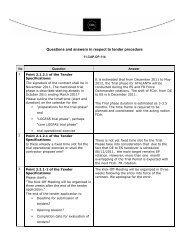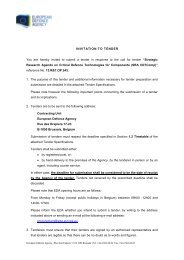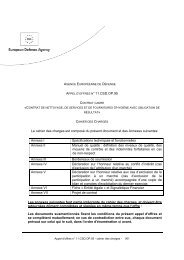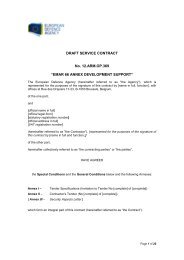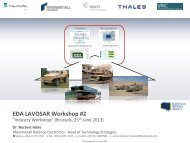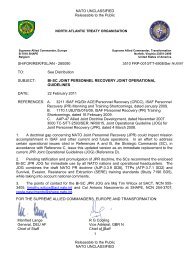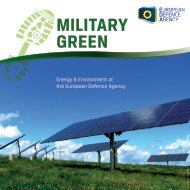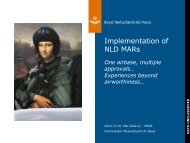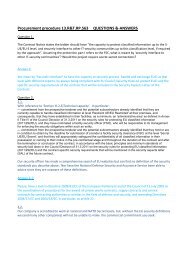capability development plan - European Defence Agency - Europa
capability development plan - European Defence Agency - Europa
capability development plan - European Defence Agency - Europa
Create successful ePaper yourself
Turn your PDF publications into a flip-book with our unique Google optimized e-Paper software.
AN INITIAL LONG-TERM VISION<br />
FOR EUROPEAN DEFENCE CAPABILITY AND<br />
CAPACITY NEEDS<br />
ad hoc coalitions. They will need to demonstrate strategic reach (expeditionary operations) and<br />
strategic agility, being able to quickly move strategic distances and enter directly into the theatre of<br />
operations, readied and prepared. Inevitably there could be instances where very short lead times<br />
apply prior to deployment, as well as minimal infrastructure provided in theatre (e.g., few adequate<br />
ports or airfields, limited host nation support).<br />
46. Forces may need to be responsive, reacting quickly, decisively and with precision, being<br />
knowledge-focussed and appropriately digitised. Such joint forces may need to be quickly tailored to<br />
meet a wide range of contingencies. Continued co-ordination between the Maritime, Land, Air, Special<br />
Forces and Logistics components will assist the trend towards jointness in smaller tailored units and<br />
task forces, if required. Such agile packages save lift, put fewer people in harm’s way, permit a higher<br />
operational tempo and the speedier application of combat effect. They will be able to show intent whilst<br />
maintaining sufficient combat power to prevail in contested operations. They will also possess the<br />
necessary command, control, communications, intelligence, surveillance and reconnaissance (C3ISR)<br />
to enable mission <strong>plan</strong>ning and rehearsal en route.<br />
47. Future joint forces will need agility at the operational and tactical levels as well as the strategic.<br />
Once deployed, EU Member States’ joint forces may need to be able to operate at will within all<br />
domains and across the depth and breadth of the operational area, possessing combinations of<br />
stealth, speed, information superiority, connectivity, protection, and lethality. They may need to operate<br />
in complex terrain and inside cities. In all cases, forces must be capable of moving quickly in order to<br />
capitalise on fleeting tactical and operational opportunities, apply continuous pressure and set an<br />
operational tempo that suits own forces but, at the same time, degrades the enemy’s decision-cycle<br />
processes and operating concepts.<br />
48. Selectivity. The selective use of kinetic and non-kinetic means to generate the desired lethal or nonlethal<br />
effects will be essential for future operations. Future forces need to be able to graduate and vary<br />
the application of force as necessary, and in accordance with legal and political constraints. Therefore,<br />
future capabilities may also effectively incorporate such nonkinetic capabilities as computer network<br />
attack, electromagnetic or directed-energy, offensive counterspace, military deception and<br />
psychological operations. Such capabilities should provide EU Member States’ forces with enhanced<br />
flexibility and allow them to better engage targets whilst constrained by concerns of collateral effects.<br />
They should be prepared to operate in less densely populated environments as well as in complex<br />
terrain and cities with discrimination, precision and minimal collateral damage.<br />
49. Selectivity makes it particularly important to determine the overall effectiveness of force application.<br />
There is a need for the assessment of battle damage, munitions effectiveness, collateral damage and<br />
effects, consequence analysis, behavioural modification analysis and the overall reassessment of<br />
mission requirements. Future analysis, linked to a comprehensive (civilian & military) EU operational<br />
lessons learned process, may need to measure the effects on behaviour and attitudes of opposing<br />
leadership, forces and populations.<br />
50. Sustainability. If an adversary can impede or deny access of <strong>European</strong> forces to needed facilities<br />
or to the local operational area, the potential impact on the crisis and its management may be decisive.<br />
The adversary gains time, extra latitude and a greater probability of success. If <strong>European</strong> forces are<br />
compelled to operate from distant areas, then their capabilities will be affected in scale, speed and<br />
endurance. The converse is that, to the degree that the EU can demonstrate an ability to deal with<br />
area denial threats, the deterrent is made more credible.<br />
51. Multinational and agile sustainability will require building sufficient capacity into sustainment<br />
pipelines, and exercising sufficient control over the pipeline from end-to-end, to provide a high degree<br />
of certainty of supply to the forces in theatre. The results could provide a more timely and precise<br />
delivery of mission-ready forces, a reduced combat support and combat service support footprint in<br />
theatre and a more cost effective fighter-to-support ratio within overall force structures. Even if<br />
sustainment pipelines remain national, a high degree of interoperability, co-ordination and use of<br />
agreed standards will be vital to achieve a unity of effort and purpose. In any case, and although there<br />
Mi171 - Czech Republic at 1st International HELO<br />
Mountain Exercise Gap-Tallard 2009 © EDA<br />
25<br />
FUTURE TRENDS FROM THE CAPABILITY DEVELOPMENT PLAN




